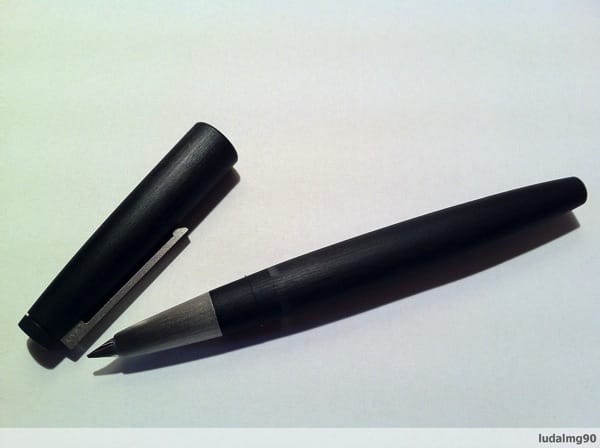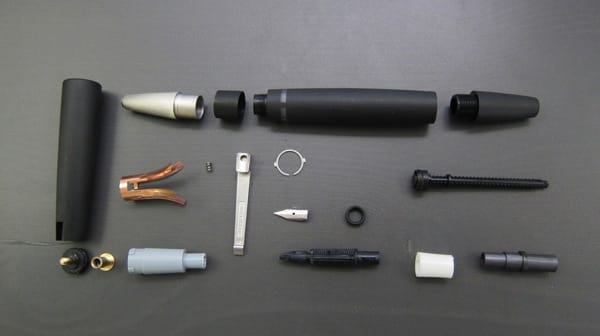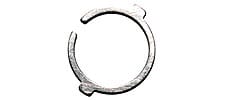Several years ago my wife bought me a Lamy 2000 fountain pen as a birthday present. It is a design classic created by Gerd Alfred Müller, released in 1966. If you like writing, the Lamy 2000 is a lovely instrument1. It is not cheap either, retailing at around 190 Euros here in Germany. One of my favourite features about it is that the syphon mechanism is almost invisible in the Makrolon barrel. Only if you look carefully do you see the join and when you twist the end the end of the barrel unscrews to draw up ink. I also like the slightly hooded nib holder and the small spring that slips between the nib section and the body barrel, with two tiny protrusions that keep the cap on. All in all it is a great balance between aesthetics, minimalism and functionality.

(Image by ludalmg90 on Flickr)
For the past year I have been using a Pelikan 200 as my everyday pen, because I had a problem with my Lamy 2000 not drawing up the ink correctly. Last night I decided to clean my Lamy and take it apart to find out what was wrong. One of the lovely things about the design is that this is all possible to do yourself with no tools. As it happened, the rubber end of the syphon had folded back on itself, which is why it was no longer drawing up ink.

(A Lamy 2000 “autopsy” by user Lamy 2000 on Flickr) on Flickr)
I left everything to soak in warm water in a bowl, tipped out the water and put the pen back together only to discover my terrible error. Every website that talks about taking apart the pen cautions owners not to lose the spring that holds the cap on. It is just sandwiched between the nib holder and the main barrel, so it easily falls out. I have always been careful with this in the past, because it is only small:

(Image from Lamyusa.com)
But I had tipped mine down the plughole like an idiot.
After much swearing and searching—even shining a torch down the plughole to see if it had got caught there—I decided I would have to order a new spring. I headed over to Lamy’s website and filled in their customer support form to see if I could order one directly from them. I was expecting to be directed to my local retailer who would make the order and expecting the usual tedium of having to find one (not hard in Germany though) and waiting for them to order it.
Instead, I had a call this morning from the very friendly Susann Kießling at Lamy customer service. I didn’t quite manage to pick up the call in time, but, when I called the number back, she answered with, “Hallo Herr Polaine,” because she must have recognised the number. An entertaining exchange ensued in which she jokingly asked me why it was always men who completely dismantled their Lamy 2000s to clean them instead of just rinsing the nib. I explained that I was trying to fix it, but felt a little sheepish nonetheless—I imagined her receiving mails every day from hapless men who had wrecked their pens.
She said she would pop a new spring clip along with the syphon head in the post today. I asked how I should pay and she said, “with a smile” to which I laughed and she responded, “so now it is paid for.” Not only that, but she also mailed me to thank me for the enjoyable conversation.
We wrote in our service design book that there is only one kind of personal and it’s to actually be personal. Reading from a script or, worse, hearing a recorded “your call is important to us, please hold” is often worse than being impersonal in the first place. Frau Kießling’s warm and humorous manner, attention to detail and desire to help an idiot customer who took apart his 190 Euro fountain pen and lost a part of it was an example of getting this very right.
This reminded me of the (possibly apocryphal) story of the customer whose Rolls Royce axel/spring broke when driving over the Alps. Rolls Royce supposedly sent out engineers to fix it and when the bill failed to materialise, the owner was informed that his must be mistaken because “Rolls Royces never break down.” I was annoyed with myself for having lost the spring and Frau Kießling not only fixed my problem for free, but also made me see the humour in it and give me a laugh in the process.
Frau Kießling could have told me it would cost 30 Euros to replace and I would have paid it, slightly begrudgingly knowing it probably cost Lamy much less than that. But I would have paid it anyway, because my pen would be useless without it. Rather than use this as a way to blackmail me out of more money Lamy did the opposite. For little cost to Lamy beyond hiring a pleasant and smart customer service representative, the cost of the spring and the price of a stamp, they’ve now got a customer who will sing their praises.
The moral of the story here is how much details matter. I feel more confident that Lamy pay attention to details in their products because I see their attention to detail in their customer service. I also see the attention to detail in the customer service as a reflection of their manufacturing quality. The values reinforce each other. Companies who believe they don’t have to bother to care for their customers once they have got their money miss out on the true profit of building lifelong relationships with them.
-
Take a look at Brad Dowdy’s review of it on Penaddict.com for more. ↩︎

